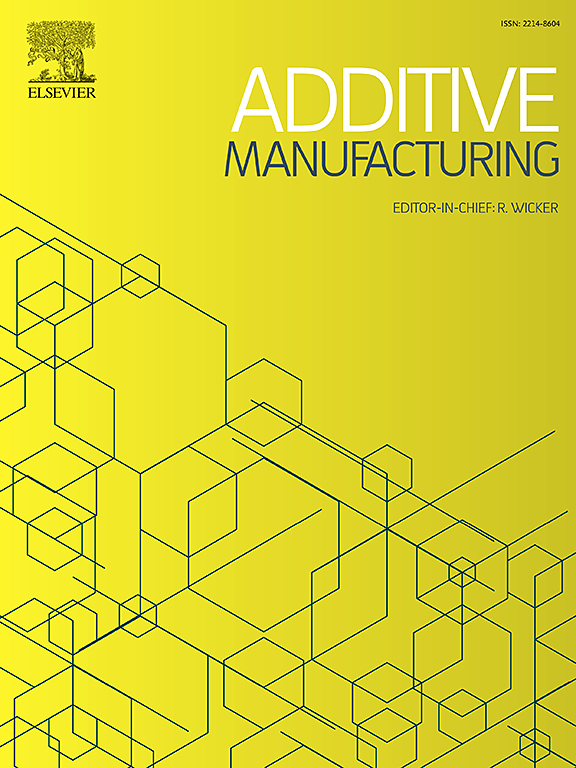The effect of thermal history on elemental diffusion, phase evolution, and mechanical properties of laser powder bed fusion fabricated Ti6Al4V/AlMgScZr multi-material components
IF 10.3
1区 工程技术
Q1 ENGINEERING, MANUFACTURING
引用次数: 0
Abstract
Ti/Al multi-material components integrate the high specific strength of titanium with the lightweight characteristics of aluminum, demonstrating significant potential for applications in extreme environments. However, challenges such as weak interfacial bonding, elemental diffusion mismatch, and residual stress accumulation hinder broader application. In this study, Ti6Al4V/AlMgScZr multi-material components were fabricated using laser powder bed fusion (LPBF), with thermal history control to optimize residual stress and mechanical properties. The effects of thermal history on Ti/Al multi-material interface were analyzed, encompassing elemental diffusion, phase interface, and mechanical performance. Results showed that heat treatment significantly enhanced elemental interdiffusion, with the diffusion layer thickness increasing from 3.74 µm in the as-built state to 26.86 µm after 425°C× 4 h heat treatment. The L12-Al3Ti phases formed a coherent interface with the aluminum matrix, alleviating lattice mismatch, enhancing stress transfer, and promoting partial ordered phases under high-temperature heat treatment. Simulations revealed that residual stress in the AlMgScZr region decreased from 282 MPa in the as-built sample to 81.2 MPa after heat treatment at 325°C× 4 h, effectively mitigating thermal mismatch-induced deformation and ensuring uniform stress distribution. This study provides new insights into the interfacial phase evolution and residual stress optimization in LPBF-fabricated multi-material systems. The synergistic effect of grain refinement and residual stress reduction led to a notable improvement in mechanical performance, with the tensile strength reaching 313.1 MPa after 325°C× 4 h heat treatment, representing a 50.3 % increase over the as-built sample. These findings offer valuable guidance for the design and processing of high-performance Ti/Al multi-material components for aerospace applications.
热历史对激光粉末床熔合Ti6Al4V/AlMgScZr多材料构件元素扩散、相演化及力学性能的影响
Ti/Al多材料组件将钛的高比强度与铝的轻质特性相结合,在极端环境中显示出巨大的应用潜力。然而,界面结合弱、元素扩散失配和残余应力积累等挑战阻碍了其更广泛的应用。在本研究中,采用激光粉末床熔合(LPBF)制备Ti6Al4V/AlMgScZr复合材料部件,并通过热历史控制优化残余应力和力学性能。分析了热历史对Ti/Al多材料界面的影响,包括元素扩散、相界面和力学性能。结果表明:热处理显著增强了元素间的相互扩散,扩散层厚度从建立状态的3.74 µm增加到425°cx 4 h热处理后的26.86 µm;高温热处理后,L12-Al3Ti相与铝基体形成共格界面,减轻了晶格失配,增强了应力传递,促进了部分有序相的形成。模拟结果表明,在325°cx 4 h下热处理后,AlMgScZr区的残余应力从原状试样的282 MPa降低到81.2 MPa,有效地缓解了热失配引起的变形,保证了应力分布的均匀性。该研究为lpbf制备的多材料体系界面相演化和残余应力优化提供了新的见解。晶粒细化和残余应力降低的协同作用使合金的力学性能得到显著改善,经325°cx 4 h热处理后,合金的抗拉强度达到313.1 MPa,比原状试样提高50.3% %。这些发现为航空航天应用中高性能Ti/Al多材料部件的设计和加工提供了有价值的指导。
本文章由计算机程序翻译,如有差异,请以英文原文为准。
求助全文
约1分钟内获得全文
求助全文
来源期刊

Additive manufacturing
Materials Science-General Materials Science
CiteScore
19.80
自引率
12.70%
发文量
648
审稿时长
35 days
期刊介绍:
Additive Manufacturing stands as a peer-reviewed journal dedicated to delivering high-quality research papers and reviews in the field of additive manufacturing, serving both academia and industry leaders. The journal's objective is to recognize the innovative essence of additive manufacturing and its diverse applications, providing a comprehensive overview of current developments and future prospects.
The transformative potential of additive manufacturing technologies in product design and manufacturing is poised to disrupt traditional approaches. In response to this paradigm shift, a distinctive and comprehensive publication outlet was essential. Additive Manufacturing fulfills this need, offering a platform for engineers, materials scientists, and practitioners across academia and various industries to document and share innovations in these evolving technologies.
 求助内容:
求助内容: 应助结果提醒方式:
应助结果提醒方式:


